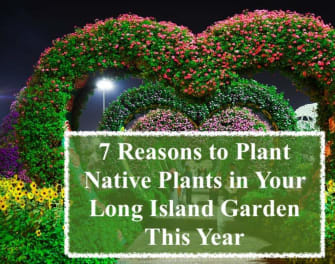Did you know that over 77% of American households are gardening? Outdoor gardens can improve your family's health and happiness. They will make your home look more beautiful and even help you burn calories and lower your stress levels.

A trip to your favorite local nursery brings with it endless possibilities.
Should you invest in annuals or perennials? How much work is a veggie garden? What is the best way to plant and nourish my flowers?
If you are new to Long Island gardening, you need to know about native plants. These are naturally found in our region, so they are used to the climate changes in our area.
Here are some reasons why you have to add them to your garden
Long Island Native Plants
Flowers that grow naturally on Long Island include lady ferns, black-eyed Susan, and butterfly milkweed. Native shrubs include winterberry, prairie rose, and winterberry. Local native trees include gray birch, sugar maple, and red oak.
You can look for native plants in the form of woody trees, shrubs or vines. Perennials in the area are hardy and designed to withstand the cold winters and steamy summers. They are ready for moderate rainfall and a four-season climate.
Wildlife in our area includes a variety of birds, insects, and butterflies.
1. Low Maintenance
Plants that grow locally require much less maintenance than those that originate elsewhere. They can tolerate the change in light and weather conditions beautifully.
Native plants are well adapted to the environment because they grow there. They require little watering. They also will not require pesticides or fertilizer.
The native plants will thrive in your local soil and climate with less assistance and effort.
2. Better For The Environment
Many native plants are effective at storing the greenhouse gas carbon dioxide, which can help combat climate change. There is also less noise and pollution from fertilizing equipment.
3. Better For Wildlife
Native plants provide nectar for local pollinators, including local birds and butterflies. They offer essential food for all forms of wildlife with their nuts, seeds, and fruits.
Native plants also provide cover for local mammals.
4. Beautification
Native wildflowers and plants and ensure seasonal interest. You can have interesting bark in the winter, and beautiful flowers and buds during other times in the year.
Native wildflowers have a variety of colors, textures, and forms that create kaleidoscopic seasonal presentations. Some have an autumn color and berries that persist in winter.
5. Biodiversity
Native wildlife comes with a variety of birds, pollinators, butterflies, and other organisms. If your garden has no native plants, it will be difficult for local insects to pollinate there.
6. Conserving Water
You will not need to irrigate native plants or water them as much as exotic plants. Native plants help the environment in your region.
7. Local Flavor
We all know those plants and trees that make us feel at home when we look at them. Native plants can bring a little of your local glory right into your backyard.
Finding Local Plants
Local nurseries are the perfect place to find native plants. They will not travel far from the grower to the nursery. Temperature and light variations will not affect them.
Local nurseries often offer healthier plants than bigger box stores. Retail stores often buy in bulk and at wholesale prices.
Local nurseries, by contrast, often purchase their plants from local growers or grow their own plants. If you are going to be a serious gardener, this is a better investment.
The knowledge and experience of the staff at local nurseries can also go a long way toward helping you pick out the right plants. They know a lot of details about the plants they carry, as well as horticulture in general.
Local nursery employees take the time to nurture seedlings to become strong, healthy plants. They use feeders and top-grade soil so plants tend to live longer. The plants will also be more resistant to disease.
Garden Plans
Before you arrive at your nursery, draw up a garden plan and figure out where you would like to place plants and shrubs. Remember that you may not find everything you need on one trip, and that is okay.
Think about any trellises or support systems that you may need for plants that need to get propped up. Remember to purchase these if you will need them!
Look at the container combos in the nursery for inspiration. It could help with plant choices, color selection, and arrangements. The right employees can help you choose native plants whose colors will complement one another on your property.
Don't be afraid to look for plants with unopened buds, as these will blossom after you get home. Plan to have something blooming throughout the season, from spring to fall.
You should add a little foliage to your arrangement, and don't rely on flowers alone. Pick up a few edibles while you are there, as there are many benefits to planting food and flowers together. Look for hardy plants.
Don't forget to get a little compost or garden soil before you leave. These will keep adding nutrients back into the soil throughout the year.
The Native Advantage
Native plants on Long Island offer a variety of advantages. You will beautify your garden, help the environment, and benefit your local ecosystem by planting local varieties. Finding a great local nursery and planning your garden carefully is worth the effort!
To learn more about Long Island native plants, contact us today.
